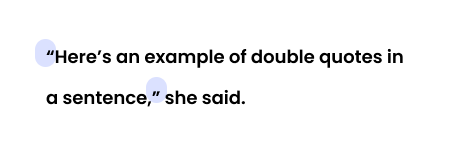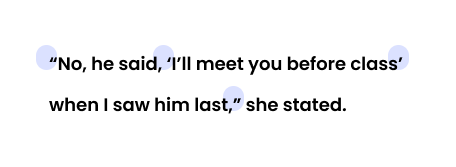How to Use Quotation Marks When a Quote Continues to a New Paragraph
Quotation marks: rules and usage in sentences

I'd wager you've probably seen at least a handful of quotation marks so far today. They're everywhere.
These upside-down commas can be tricky if you don't understand the rules.
For instance, when should you use a single quote or a double quote? Where does the punctuation go?
In this post, we'll cover the differences in single and double quotation marks, common quotation mark rules (including the Golden Rule), and when to use quotation marks.
What's the difference between single and double quotation marks?
Single and double quotes have different uses but are commonly mixed up by writers. It's hard to tell the purpose of the quotation marks if they're used incorrectly.
In general, double quotes should be used to indicate direct speech in your writing. Double quotes look like this and are highlighted in the example below:

Single quotes aren't used in the same way as double quotes, but they're often used in the same sentence as them. Single quotes are used to indicate a quote within a quote. Single quotations can also be used to show a quote within a headline or a title placed within a quote.
Here's an example of what that would look like with the single quotation marks highlighted:

It's important to note that quotation grammar rules vary between American English and British English, which can be a challenge for international students. For this post, we'll focus on quotation rules that affect American English writing and literature. If you're writing in British English, be sure to consult your styleguide or other relevant writing references.
Before we dive into when you should use quotation marks, we first need to cover some ground rules.
What are common quotation mark rules?
When it comes to quotation mark usage, there is one Golden Rule you need to know:
Once a quote is open, it has to be closed.
Essentially, don't start what you can't finish. If you have an opening quotation mark, then you'll need to close the word, sentence, or phrase with a closing quotation. This means that leaving a quote open like this is incorrect :

Can you spot where the closing quotation needs to go? The closing quote should be placed directly after the comma beside the word backpack . Think of quotes as existing in pairs. If you start a quote, it needs to be followed by its buddy.
Aside from the Golden Rule, there are a few additional quotation mark rules.
3 of the most common quotation mark rules you need to know
1. Using quotes within quotes
This was already mentioned above, but it's an important rule to remember. When you're quoting something inside of an existing quote, you should use single quotes within the quote.
Here's an example of what a single quotation mark looks like for a quote within a quote:

As you can see in the example above, the closing quotations almost look like three marks. That's what it looks like when you have a single quote next to a double quote. It might seem odd, but it's grammatically correct.
Here's another example. In this case, the quote within the quote is smack-dab in the middle instead of butting up next to the closing double quote:

2. Capitalization and quoting
Text within quotation marks is sometimes capitalized and other times not. It strictly depends on the quote itself. The first letter of the text should be capitalized if you're quoting a complete sentence. Here's what that looks like as an example:

This would be true even if the quoted phrase fell in the middle of a sentence. You would still need to start it with a capital letter in that instance.
But a quote doesn't always have to start with a capital letter. If you're simply quoting a piece of the sentence or a phrase, then you can start the quote with a lowercase letter. Here's an example of that:

3. Using quotes with other punctuation
It can be confusing for writers trying to figure out whether punctuation marks go inside or outside of quotes. For this rule, there are a few tips to keep in mind to help you place punctuation marks in the right spot.
For instance, punctuation marks that introduce the quote shouldn't be placed within the quotation mark. But sentence-ending punctuation marks follow different guidelines. Sentence-ending periods and commas go within the quotation marks while semicolons, dashes, and colons are placed on the outside of the quote.
Here are two examples to show the difference in sentence-ending punctuation placement:

Exclamation and question marks are another story. They can go either inside or outside of the quote, depending on the context. If the punctuation mark applies to the quoted word or phrase, then they should be placed within the quotes. If they apply to the entire sentence instead, then they go outside of the quotation marks.
Here's an example to show you the difference:

When to use quotation marks
Here are some examples of when quotation marks should be used and how they can be applied to your writing.
1. Quotes within quotes
As stated above, quotes within quotes are commonly used. These require a single quotation mark inside of double quotation marks.
He said, "I love the theater. I went to see 'Sample Performance' last week."
In this example above, the single quotes are framing the title of a show.
2. Quotes within quotes
Remember that a single quote should still be used when it's followed directly by a double quote, such as in this example:
She said, "My favorite album is 'Sample Band Debut.'"
3. Words as words
You can also use quotation marks to refer to a word. Here's an example:
Effective "copywriting" can persuade people to take a desired action.
The quotation marks in this example show that you're talking about the word itself, and it's not a direct quote from someone.
4. Scare quotes
Scare or shudder quotes are used to imply a term is being used in a nontraditional way or the writer is trying to distance themselves or the subject from the word. For example:
She thinks she's a "talented" artist.
The use of quotation marks here shows that the writer doesn't necessarily think the person is talented. Keep in mind that scare quotes can easily be overused, and you should try to use them sparingly in your writing.
5. Titles of short works
Titles of short works like poems, articles, blog posts, and chapters should use quotation marks. However, larger pieces of work such as novels and magazines would be italicized, according to many styleguides, including Chicago. Here's an example of a short body of work in quotation marks:
'How to Write' was an interesting article.
6. Direct quotes
Direct quotes are possibly the easiest and most straightforward use of quotes. When you're quoting someone's direct speech, add quotation marks. Here's an example:
"I only have two classes left today," she said.
Quotation marks follow many rules, but they aren't too complicated. Just keep practicing to get the hang of it. And of course, you can always bookmark this post to use as a reference.
Looking for more ways to improve your writing? Start a free trial today to see the benefits of Writer.
Source: https://writer.com/blog/quotation-marks/